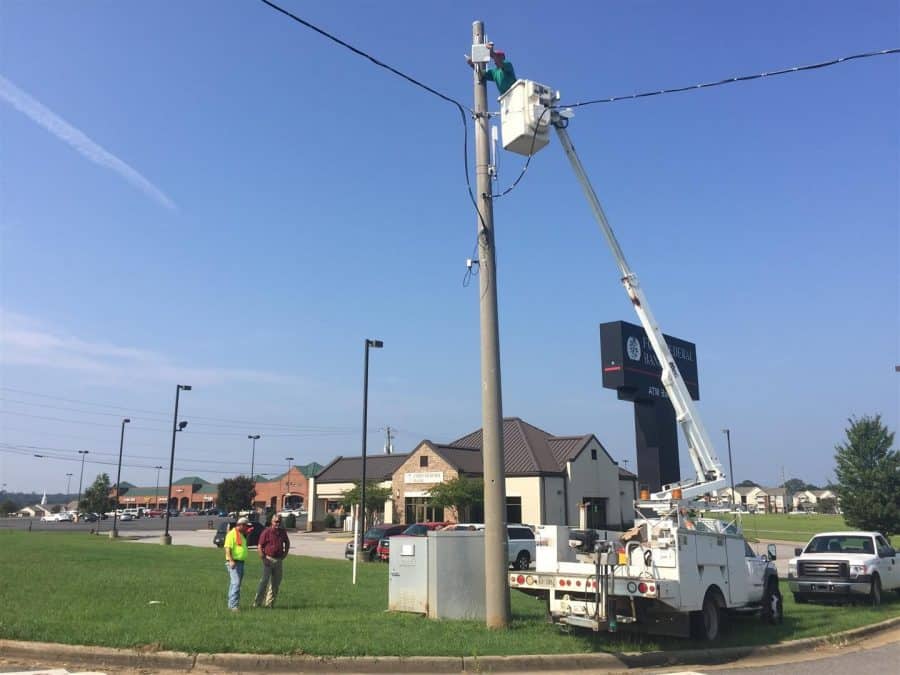Technology is moving faster today than it ever has. Phones recognize the faces of their owners, artificial intelligence serves as a household assistant, and steps are being taken to make self-driving cars a reality.
The Alabama Department of Transportation (ALDOT) and The University of Alabama are working together to install devices that will collect road and traffic data to make driving safer and more efficient for Alabamians.
To collect data, the two groups will install devices at major roads and intersections in the Tuscaloosa and Northport areas. These new traffic devices are called Dedicated Short Range Communication (DSRC) units.
“Their job is to gather information that allows greater interaction between vehicles and traffic signals to communicate information like road conditions or changing signals,” said John McWilliams, public information officer for ALDOT.
Alexander Hainen, a assistant professor of civil engineering at The University of Alabama, is one of the minds responsible for bringing DSRC into Tuscaloosa. He said ALDOT had him talk with many people about this technology. After going to several national conferences and seeing what other states were doing, he decided DSRC is the next step in transportation technology.
“The DRSC is more recent,” Hainen said. “These pull back data over fiber optic communications that we have. That is something that TDOT [Tuscaloosa Department of Transportation] set up and we’re really thankful for that. We wanted to know what new technology is coming and it really is that dedicated short range communication technology for vehicles to be able to communicate with each other.”
While it should be noted that automated vehicles will not be available in this decade, the two organizations are taking important steps to set the groundwork for vehicle automation.
“[Automated cars] will happen eventually,” McWilliams said. “While it’s challenging, it gives us something to work forward to.”
A significant collaborator on this project is Bharat Balasubramanian, executive director of the center for advanced vehicle technologies and former vice president of German automotive company, Daimler.
In explaining the DSRC technology, Balasubramanian, an engineering professor at the University, referenced the SAE Levels of Automation for automated vehicles. This is a classification system created by SAE International, an automotive industry company. Level 0 requires total human control of the car, Level 1 is cruise control, and Level 2 is partial automation. Level 3 is not yet available in vehicles, but engineers are currently working towards it.
“[Level 3] is the point where you can do something else while still in the driver seat,” Balasubramanian said. “You can play with your smartphone or if you’re a truck operator, you can prepare your invoices. But you still need to be available should the system request your help in ambiguous situations.”
Balasubramanian said any level beyond Level 2 will require highly reliable roadmaps. Unlike maps on phones and in cars today, these maps need to be updated in real time. That is where the DSRC devices come in.
“The DSRC is for traffic safety and traffic management,” Balasubramanian said. “It’s technology like our phones with a dedicated range. It operates at 5.9 GHz. Against a phone, if I called [someone] now, it’ll take five seconds to build up the connection. With DSRC, it will be done in tens of milliseconds so it’s almost instantaneous.”
Roadside DSRC units will be sending the messages to the vehicle, the automated vehicle will pick it up instantaneously and depending on the content of the message, the driver or vehicle will need to react upon it. This will be useful for drivers because it will help them avoid scenarios like crowded construction zones or debris on a highway.
Balasubramanian estimated that by the end of the year, half of the DSRC devices will be implemented around Tuscaloosa and Northport at all major intersections. The devices will be about the size of an average laptop and will minimize delays at intersections, improve the operation and performance at intersections, decongest traffic, decrease wrecks and fatalities, and increase driving efficiency for emergency responders.
McKinnon Cox, a sophomore aerospace engineering major and SGA senator for the College of Engineering, is excited about the installation of the DSRC devices.
“I’ve been hearing about everything going on in California,” Cox said. “To see this going on where we live is a step in the right direction. I think it’s really great, making driving safer for everybody.”







